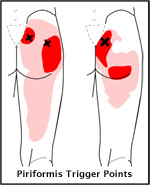This is a series on low back pain. If you missed the summary of causes, go back to Part 1.
For those of you who consider your low back the part below your waist across your sacrum and into the top of your buttocks and the back of your hips, the piriformis muscle could be your nemesis. Twenty years ago the piriformis was rarely documented. Now doctors have heard about it and have even named a syndrome associated with it. In my experience as a Neuromuscular Therapist near Boston, I find that it is almost always involved in causing low back pain.
 One of the most important things to know about the piriformis is that it attaches to the sacrum, the base of your spine. It “interdigitates” with the sacral nerves meaning that if your spread fingers are your piriformis muscle, the sacral nerves would be coming up in between your fingers. You can see then how tension in the muscle would affect the nerves. The first sacral nerve partially innervates all three of the glutes and the first and second both innervate the piriformis. All of the sacral nerves form part of the sciatic nerve that serves the back of your thigh, leg and bottom of your foot. Compression or irritation of the sacral nerves causes problems in the muscles they innervate.
One of the most important things to know about the piriformis is that it attaches to the sacrum, the base of your spine. It “interdigitates” with the sacral nerves meaning that if your spread fingers are your piriformis muscle, the sacral nerves would be coming up in between your fingers. You can see then how tension in the muscle would affect the nerves. The first sacral nerve partially innervates all three of the glutes and the first and second both innervate the piriformis. All of the sacral nerves form part of the sciatic nerve that serves the back of your thigh, leg and bottom of your foot. Compression or irritation of the sacral nerves causes problems in the muscles they innervate.
Speaking of the sciatic nerve, when the piriformis is hyperactive it can bulge and press on the sciatic nerve. The nerve entrapment causes irritation, and loss of sensation and function along it’s pathway. That’s piriformis syndrome.
 Trigger Points in the piriformis muscle refer to the sacroiliac joint and the back of your hip and butt. There’s your low back pain.
Trigger Points in the piriformis muscle refer to the sacroiliac joint and the back of your hip and butt. There’s your low back pain.
If you lift or push a heavy object with your feet turned out, you are overloading the piriformis. For you long-legged people, if you drive a car for a long time with your knee flopped outward, that prolonged shortening stresses the muscle.
When the piriformis gets tight, it can cause sacroiliac joint compression. It can also maintain joint misalignment when the SI joint goes out of position. All of these situations cause low back pain.
The contribution of the deep core muscle called the iliopsoas will be discussed next.